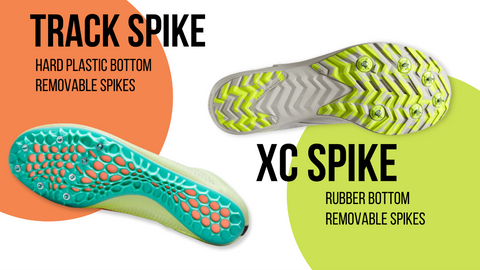Everything you need to know about Track & Field Spikes
When trying to pick out your track spikes for the season there can be an overwhelming amount of options! We’re going to help simplify the choice for you here. You can look for the events that you are doing and then find many of the options we carry below the header.
Indoor vs Outdoor
This can be a confusing distinction, because sometimes it matters and sometimes it doesn’t. When you race at a really nice college track, they’ll have the same material as an outdoor track and you’ll be able to wear your spiked shoes. However many local meets at high schools will be on a gym floor surface. You won’t be able to wear a spiked shoe, so instead you’ll want a racing shoe that is all rubber on the bottom. There are two options; a “cross country spike'' or a racing flat. Both would be used for all distances/events. With most cross country shoes you’ll get a full rubber bottom and you can either put the spikes in or run without them. When you race indoors you’ll take the spikes out! If you go with a racing flat you’ll have a lower profile shoe with good grip. The rest of the shoes we’ll talk about from here are those “outdoor” spikes. Again they can be used oftentimes at the bigger indoor meets at the university tracks as well as throughout the outdoor season.

Sprint vs. Distance
First off we’ll go over the difference between sprint spikes and distance spikes. With a sprint spike you’ll typically see a full length “plate” or a ¾ length hard plastic “plate.” A plate is a stiff material at the bottom of the shoe that helps create more stiffness and allows you to put more power out. The sprint plate will be stiffer and put your foot in a more “aggressive” position. This means that you will be pushed up onto your tip-toes.
With a distance spike you’ll typically see a thicker midsole, and a shorter plate. There will also be a noticeably less “aggressive” position for your foot. You’ll be closer to level with the ground. This is because these shoes are meant to run 1-6 miles on the track at a time!

Sprint Spikes (55, 100, 200, & 400)
Built for speed, these are going to be stiffer, tighter, and faster than anything else you can find. You’ll see a wide range of prices which reflects the quality of the spike. The lightness of the materials, the stiffness and power output of the spike plate, and the aerodynamics of the shoe can all play a part. We’ll show a few shoes below here:
What the Olympians and many state champions are wearing?
Other Sprint Spikes:
Middle Distance Spikes (400, 800 and Hurdles)
Build for the 400, 800 and Hurdles - or when you aren’t really sure what events you’ll be doing, you’ll often end up in something called a middle distance spike. These shoes are designed to do everything pretty well. So especially for beginners these often make sense. You’ll be able to sprint, jump and run distances in these shoes.
Some Middle-Distance Spikes:
Distance Spikes (800, 1600, 3200 & Up)
Built to go a long way quickly, distance spikes are meant to be light and comfortable. Just as with the sprint spikes you can find a big gap between the elite level spikes and the entry level. With the better spikes you’ll find lighter materials, more responsive midsoles, and carbon fiber in the shoes to create more force. Many distance track athletes wear their cross country spikes for track.
What the olympians and many state champions are wearing:
Other Distance Spikes:
Jumping Spikes
There are two main types of jumping shoes, the horizontal jumps (Long Jump and Triple Jump) and the vertical jump (High Jump.) The high jump shoes will have spikes in the heel as well as the forefoot so as to allow the athlete to grip while turning, something you really only do in the high jump. While the horizontal jumps will often have their own specific shoes. You’ll be able to do both jumps in either of the shoes, but the Long Jump will more closely resemble a sprint spike, since you are trying to go as fast as you can before cannonballing into the sand. While a Triple jump spike will have more cushion since you have to hop, skip and then jump off the harder track. Some brands will combine those two spikes into one and just call it a jumping shoe, but that will still be different from the High Jump spike.
High Jump:
Long jump / Triple Jump:
Throwing Shoes
Throwing shoes are the most unique out of all the track shoes. They’ll have a smoother bottom and are built for rotation. There is a single point up on the ball of your foot that you can spin around for. The discus and hammer throw are especially built for this, and many shot putters as well. The shoes will have a rubber bottom so if you use the glide technique (you almost shuffle from one end of the throwing circle to the other) you’ll still be able to grip and throw.

Examples:




Comments
smret tameret —
I’m currently doing track and field that my first year of high school and i’m doing 200 and 400 m races and I was wondering if the sprints weeks are perfect for me to run in